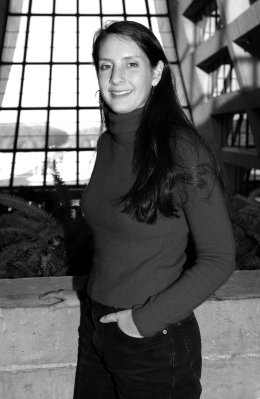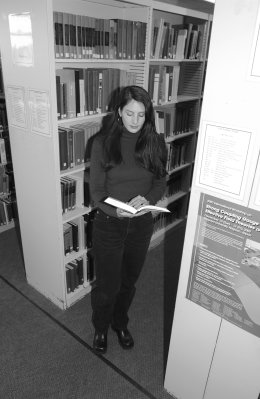 |
|
A Year in the Life For a young researcher, the payoff is in data - and in the common cause by Robin D. Erbacher
I straightened up and leaned forward to listen while I struggled to contain a large grin. Oh,I wasn ’t the only one. When our co-spokesperson, Prof.Al Goshaw of Duke University, had finished the announcement at the CDF meeting on December 5, the room filled with spontaneous applause, and grins were everywhere. The first publication of results from CDF Run II was ready for review by the collaboration. We all realized at that moment that the investment in long hours, grueling work, diligent planning, modeling, testing, programming, debugging and repairing (not to mention the investment in funding) were all beginning to pay off with insights into the important questions that we ’ve all set out to answer. Of course, some had waited longer than others. I joined CDF as a Fermilab postdoctoral Research Associate three years ago, but while I had more invested than some of the newer members of the collaboration,it is small in comparison to those who have been with CDF throughout the entire Tevatron and detector upgrades (which began in 1996).These veterans have been involved in carefully planning every stage to maximize our ability to gather interesting and varied physics data within the constraints of time, budget,and machine design.Still,these three years have been extremely demanding,and this past year in particular has been difficult at times for all of us,new members and senior members alike.
LOOKING FORWARD TO DATA With the Tevatron upgrades, we had anticipated ten times more data than in Run I.Naturally our detector needed improvements to handle this increase. We had essentially built a new CDF, and re-instrumented what remained of the original. We used state-of-the art,custom-built electronics, more aggressive detector technology and new computing power,and we made many design changes. I had spent two years on our new Fermilab- designed calorimeter signal readout boards,along with all of the associated infrastructure — installing,burning-in,understanding,debugging,replacing, reading out,and calibrating. I had worked long hours with my colleague, Rick Tesarek, to reduce noise, repair broken channels on the calorimeter, and generally make the detector readout as stable and reliable as possible for Run II. We (along with most of the detector operations experts) had handled hundreds of calls on the pager at all hours of day and night, during a very successful commissioning run the previous fall,and during the startup of Run II in the spring of 2001. By the end of last year I was also finishing up important studies of calorimeter timing and performance and was preparing to decrease my detector duties.I wanted to begin to analyze the large amounts of data we expected to receive in 2002. In November 2001,I had the opportunity to give a CDF Run II Status and Prospects talk at a particle physics workshop in Zacatecas,Mexico. Although the collision data were coming in more slowly than expected,we had reason to believe that improvements were imminent.In my presentation,being able to describe how well things were working on CDF,how far we ’d come, and what our physics goals were for Run II made me all the more excited for what lay ahead in 2002. The mood changed perceptibly by late winter of this year. We were seeing only small improvements from the accelerator front.The reconfigured accelerator is a mixture of old and new,and maintaining it while trying to maximize the operation time has proven difficult. In addition,the complexity of running it in the new configuration and with the new Main Injector has provided a major challenge to the accelerator experts. After all,colliding small bunches of protons and antiprotons in two locations around a four-mile ring every 396 nanoseconds (a nanosecond is a thousand-millionth of a second) is,well,hard!
A QUESTION OF TIME And I was happy to begin analyzing the data coming in,which will still be several times more than we obtained during the first run.Some Fermilab employees on CDF formed analysis groups in the spring to better coordinate our work, and we started on studies of the trigger and studies of jets (jets are a sort of spray or cluster of particle decays in our detector). Things were looking up for us. Yet I had my own challenge. We could not find replacements for Rick and me to train, for supporting the calorimeter front-end electronics. While the time commitment had reduced substantially, there were still weekly tests, follow-up, monitoring, test-stand work, meetings, detector accesses for repairs, and pager calls. I remember one morning being awakened at 1:10 am by the alarming beep of the pager. I had only been asleep for maybe an hour, but I threw on some clothes, shoes, and a jacket and drove on in to the CDF control room. A calorimeter power supply had tripped, and they needed an expert to reset it. Sometimes this goes smoothly and I’m done in an hour. This time, the supply didn ’t revive. I reset it again and it worked this time. The problem was that the power-cycling had inadvertently tripped a muon detector power supply. The muon electronics expert (Hyunsoo Kim,University of Illinois Urbana-Champaign) had to be called. He was actually still in his office. We cycled the power again,and this time neither of the supplies came back. And so on. I finally had to catch a few hours of sleep in the morning and get back for a meeting at 11 a.m. I had expected to pass on my detector duties in October 2001, then December, and then this April. But April came and went, and I was still responsible for the calorimeter while trying to analyze data. Physicists cannot ignore problems under the guise of “not my job.” We all need each portion of our project to work,and work well,so we take responsibility until someone else can take over. Relief came during the accelerator shutdown for repairs in June. I took Mark Mattson and Zhibin Huang (Wayne State University)and Vivek Tiwari (Carnegie Mellon University)down onto the detector and showed them how to replace electronics,check cables, work safely on a lift with a harness,and generally maintain the calorimeter electronics,performing checks on a weekly basis. But in the middle of this busy spring,I had the chance to take a broader view of particle physics, working to increase communication within and beyond the field.
CARRYING THE MESSAGE In May I helped the UEC organize a meeting of some 70 students and postdocs,in which senior people in the field shared their job experiences in academia and industry.In June,I chaired the Annual Fermilab Users ’Meeting;we developed a full program on the research going on at Fermilab, following up on the previous year ’s meeting,which had focused mainly on future projects. Everything changed in July. Rick and I handed over our pagers to our newly trained experts, and I was able to move to cell phone backup support only. At the end of the month I had the opportunity to travel, along with several of my colleagues,to the big international summer conference,ICHEP in Amsterdam,to give a talk on the integrated calorimetry system we had developed for CDF Run II. To me, it represented the culmination of the work I’d done on the detector.(Although now, in December,I am still documenting the detector work,and performing more studies of the calorimeter.Once you are deemed an expert, problems follow you,but these challenges are part of what makes this job so interesting.)During the conference in Amsterdam we received word that the Tevatron had delivered record luminosity, and was performing consistently better than it had previously. CDF co-spokesperson Franco Bedeschi of Pisa,Italy, was able to report this good news to the world during his summary talk in Amsterdam, and we were all optimistic once more. Since July,the accelerator has performed increasingly well,thanks to heroic efforts in the Beams Division.In October,Fermilab did well in the Department of Energy ’s Lehman Review of Accelerator Run II.There are still problems to solve,but the machine operators and accelerator physicists are working tremendously hard.I imagine it ’s like an old house.You find you have a problem with a leaky faucet,but after a time you figure out how to turn the faucet slightly to the left and the leak is gone.In this case,the operators are finding all the right positions and parameters to allow our machine to perform at its peak. Also since July, I have taken on new challenges.Our analysis group decided to work in conjunction with other members of the group studying the top quark,and to make a measurement of the top quark cross-section,a kind of measure of the production rate of the top quark,which was the major discovery in Run I,in 1995. We have the chance to make a much stronger measurement with the increasing data we are collecting,and now the entire top group is focused on getting results out for the important winter and summer conferences in 2003.The work is challenging, demanding,and stressful at times due to our push for deadlines, but we are problem-solvers by nature.Again,that ’s what makes the job so interesting.
SUCCEEDING
TOGETHER Yet even with the stress,and with the various problems that we encounter and solve on a daily basis,we feel a sense of optimism,excitement, and urgency for our research.In the meeting room that day,when we all realized that physics results were finally on the horizon,we genuinely felt our common success.It didn ’t matter what topic the first publication covered,or whose analysis result it was. At that moment,we were a team:everyone in that room,along with all of the 700+members of CDF from 59 institutions in 12 different countries.We were beginning to announce the discoveries we are making here at Fermilab,at the frontier of high-energy particle physics,and we had all struggled together to reach this moment. “With the Tevatron upgrades,we had anticipated ten times more data than in Run I …We had essentially built a new CDF,and re-instrumented what remained of the original.”
|

